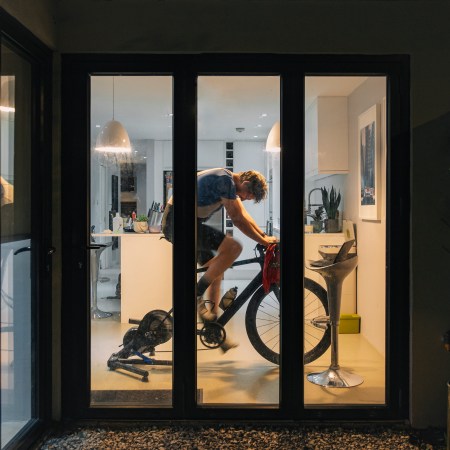Michael Mason has been described (to his own delight) as “Liver King on a budget.” Daily Instagram videos feature the 59-year-old in his chilly Brighton backyard, lifting an array of junkyard gym equipment: plates, kettlebells and resistance bands that don’t have the gleam of a new set from Rogue. He puts them to good use, though, in an offbeat fashion that deserves consideration for your strength training routine.
Mason’s a bit of a renaissance man. He’s a Swiss-qualified ski instructor, teaches Japanese martial arts and operates survival retreats in the Scottish Highlands. These sorts of mobility multi-hyphenates tend to bring a different perspective to old-school, pick-up-and-put-down weightlifting, and Mason doesn’t disappoint. He’s been posting his “slow rep series” for many months now, breathing some new life into a lifting technique that has drifted in and out of vogue over the years. Take a peak at an example of this sort of training in the video below.
(N.b. Mason also observes an aggressive carnivore diet, which isn’t necessarily how we choose to fuel up, but to each his own. A good reminder that you don’t have to agree with every single wellness choice a trainer/athlete/colleague espouses in order to find inspiring “stealable items” in their routine!)
How to Do It
In the most basic (and not-so-shocking) terms, slow-motion lifting involves lifting a weight and bringing it back down as slowly as possible. Each half of that process should be done at caterpillar pace. Think: at least 10 seconds of bringing a weight up, and at least 10 seconds of bringing it back down.
The fitness prophets long associated with this approach to strength training (Arthur Jones, Ken Hutchins, Dr. Doug McGuff) actually advocated for “super slow” training as an example of high intensity training, believe it or not. These days, we typically associate that phrase with intervals on a stationary bike or rounds of burpees on the gym floor. But performing any exercise at a slow pace — without the benefit of momentum — certainly qualifies as “intense.” Devotees talk about shaking through sets, their muscles gradually reduced to pudding (a good pudding).
Health clubs and YouTube trainers have tried to standardize the concept of slow-motion lifting throughout the years, calling for an exact number of slow-motion minutes a week, or arguing that this pace of strength training has better results than all others. Well, science isn’t so sure on whether this sort of lifting builds bigger and better muscles. But does it really matter? What slow-motion lifting will do is give you something new and challenging to try in the gym, breaking you out of whatever malaise you’re feeling with your current routine.
Why Missing a Lift Day Isn’t the Big Deal You Think It Is
You’ll get ’em tomorrow. Or three weeks from now.T.U.T.
“Time under tension” (TUT) refers to the amount of time a muscle remains under strain during a set. In a normal lift, good TUT would be about 30 seconds of strain during the course of a set. In slow-motion lifting, it isn’t uncommon for a single rep to take 30 seconds. We took the liberty of timing Mason’s repetitions above — he’s coming in around 38 seconds each time. It’s a tremendous effort.
That isn’t only good for the muscles by forcing them to work harder, increasing muscle fiber recruitment, hypoxia and, eventually, hypertrophy. But it also compels you, the trainee, to master the mechanics of whatever move you’re doing. It’s difficult not to register imperfections in your form when you’re essentially performing IRL freeze-frames of each incremental shift in the move. This is a great way to dodge injury, focus on breath and build your confidence in the gym.
Guys like Mason tend to celebrate the philosophical tilt to this sort of lifting, and that’s cool, too. “I love the feeling of being totally immersed within my body,” he says. “It’s the strongest form of mindfulness.” Plus, while some at the gym lift faster because they’re trying to fit in the workout before family stuff or a work meeting, you might be surprised to hear that a well-executed slow-motion lift isn’t going to take longer than 20 to 30 minutes. The reps are slow, but the burn comes on quick. It simply isn’t likely (or advisable) that you’ll go much longer than that.
What if I Look stupid?
This is an understandable lifting-related concern in general, which we somewhat addressed in our introductory lifting guide. The simple answer: screw ’em. Don’t worry about it. Some of the people side-eyeing your super-slow moves in the gym mirror are probably judging you. But that doesn’t mean they understand what you’re up to.
The well-informed lifters, anyway, would be the ones to recognize an alternative method that works, as slow-motion lifting mimics credos they already hold dear — stuff like giving lighter weight a chance, remembering drop-sets, mixing in bodyweight and resistance bands, and lengthening sets. That’s not to say hardcore lifters aren’t tossing around huge weight anymore. Of course they are (learn more about sub-maximal lifts here). But volitional fatigue — getting to that earthquake feeling in the arms or legs — is certainly in vogue.
Some Sample Moves
You’re only limited by your imagination here. Just try to keep the weight light to start, and aim for six reps or less. Think 100 to 200 seconds per set, for whichever exercise you choose to do. We suggest starting with deadlifts, pull-ups, plate curls, kettlebell squats and band variations.
Oh, and if slow-motion lifting has you utterly convinced, remember that explosive movements are critical, too. Don’t dismiss them forever. Mason happens to be a burpees master and likes to mix slow-motion, eccentric lowering with the quick and powerful up-thrusts we associate with conventional strength training. (Check out one such move here.) New ideas, old tricks — it can all coexist. And the more open-minded you are, the less likely you are to abandon your gym membership entirely.
This article was featured in the InsideHook newsletter. Sign up now.























